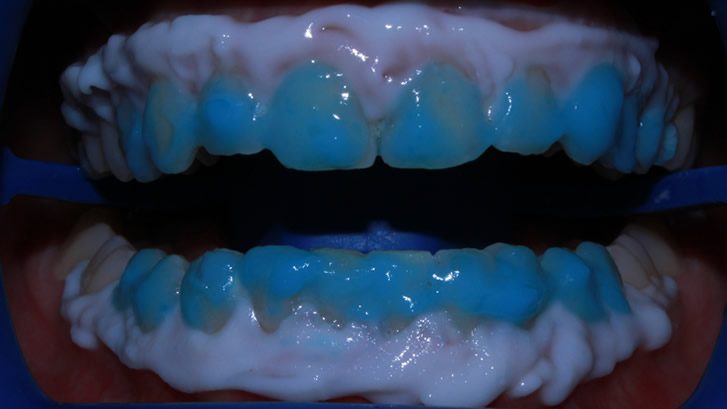
TEETH WHITENING
This is one of the most frequent questions asked by patients. Considering the fact that most patients are not informed or are misinformed about whitening treatment, below you will find a complete explanation about this dental treatment so popular in the world, but much discussed and misinterpreted in Albania . Our aim is to inform patients with scientific facts and references from the most famous dental associations in the world. At the bottom of the page you will find Toronto Dental’s position on this treatment.
What is teeth whitening
Teeth whitening or teeth bleaching is the most popular aesthetic treatment in the world. American women spend over 1.4 billion dollars a year on teeth whitening treatments and products. The reason is simple: “Everyone wants to have a healthy smile and white teeth”. A beautiful smile and white teeth can increase the confidence of people who have tried to hide their smile for years. Based on the statistics of the American Academy of Cosmetic Dentistry, 99% of people think that a beautiful smile is an asset from a social point of view, 74% think that an unattractive smile can affect the chances of getting hired.
What are the methods for teeth whitening
There are two types of treatments: the professional treatment which is done in a dental clinic for 60 minutes and is called “in office teeth whitening” and the treatment at home “at home teeth whitening or custom whitening trays”. In addition to these methods, there are also “over the counter” products such as “whitening toothpaste” or “whitening strips” which can be purchased by anyone at the pharmacy.
Are these products advisable?
The professional treatment is performed by the dentist who uses materials that can only be purchased through dental warehouses from licensed dentists since the use of these professional materials by individuals in home conditions can cause serious oral problems such as burning of the gingiva, damage to the nerves of the teeth , severe pain, etc. The difference between professional bleaching material and that for personal use is the higher concentration of hydrogen peroxide (35% for professional and 15% for personal use).
Carrying out the treatment at the dentist is of course “safer” because the treatment is carried out under the supervision of the dentist and has higher results as a result of the higher concentration of the material. In 90% of cases, patients only need 60 minutes of treatment at the dentist to get the maximum possible results. Depending on the case and the expectation of the patient’s results, home treatment may be recommended by the dentist to maintain the results obtained from professional treatment.
What are the ingredients inside the teeth whitening material?
The dental bleaching material can be in two forms: powder/liquid or gel. The main ingredient responsible for whitening is hydrogen peroxide (some products may contain carbamide peroxide which is supposed to turn into hydrogen peroxide after application to the teeth) Most dentists prefer hydrogen peroxide as more efficient.
How is whitening done?
Before the whitening treatment, the dentist analyzes your dental and medical history to identify possible problems that could make the treatment impossible. Diagnosis and preliminary consultation are necessary before any whitening treatment. The patient has the opportunity to ask questions and receive answers from the dentist regarding the treatment.
The gingiva is isolated with a protective barrier and then the whitening material is placed, which is changed every 20 minutes. The oxygen in the active gel penetrates the tooth structures through several pores, making it possible to move the color molecules from the inside to the outside of the tooth. In order for the treatment to give the desired results, it should last at least 60 minutes or 3 sessions of 20 minutes each. During the treatment, the dentist monitors the situation by modifying the treatment to avoid the effect of the patient’s sensitivity.
Is it normal to have sensitive teeth during or after the procedure?
The sensitivity effect is the only temporary side effect known to date. This is a temporary effect and usually disappears completely after 24 hours. If your dentist examines your teeth before treatment and has applied the right materials in the right way, sensitivity can be avoided in up to 95% of cases.
Who are against the indications for teeth whitening?
- Adolescent under 15 years old
- Hydrogen peroxide allergy
- Broken teeth (these must be restored before the whitening treatment)
- Patients who are pregnant or breastfeeding
Diseased gums (teeth cleaning is necessary before whitening)
How often should i do teeth whitening?
If you maintain good oral hygiene (brushing your teeth twice a day and flossing every day), avoid the routine consumption of foods that release strong pigment (coffee, red wine, cigarettes, etc.) and clean dentist every 6 months, your whitening results can last from 2 to 5 years.
Are the results of teeth whitening permanent ?
No, whitening results are not permanent. Since the consumption of food is vital for humans, the teeth will always absorb the color of the products you consume. It is important to maintain good oral hygiene and to visit the dentist regularly for routine examinations and teeth cleaning.
What causes yellow teeth?
Teeth colors are divided into external (extrinsic stain) and internal (intrinsic stains). External colors are obtained from the food we consume and are easier to remove with whitening treatment, while internal colors can be the result of taking fluoride tablets (fluorosis), tetracycline (tetracycline stain) at a young age ( 1-13 years old phase in which teeth are formed). There are also other colors that have genetic origin, but they are very rare compared to the above mentioned colors.
Can I whiten my teeth if I have fillings, porcelain crowns or veneers?
Understand that the whitening gel only works on natural teeth. Other materials do not change color. However, if the fillings are of a certain size and position, they may not be an obstacle to the whitening treatment. If you have porcelain veneers, veneers or substantial fillings, consultation with the dentist will decide whether you can benefit from this treatment or not.
Does teeth whitening damage the enamel?
The short answer is NO, teeth whitening as a treatment has no negative effect on tooth enamel. There is no scientific source to prove that hydrogen peroxide causes negative effects on the teeth. It’s unbelievable, but all new patients at Toronto Dental think that teeth whitening damages the enamel.
To the question: “Why do you think that teeth whitening damages the enamel”? they answer: “My previous dentist told me that it damages the enamel”.
Of course, our goal is not to change the mindset of any dentist, but what we can do is change your mindset by encouraging you to make decisions based on reliable information about oral health and what you should expect from a dental service. not only at Toronto Dental but at any dental clinic you choose to be treated
Below you can read the references about this article:
American Dental Association (ADA)
American Academy of Cosmetic Dentistry
Canadian Dental Hygiene Association (CDHA)

